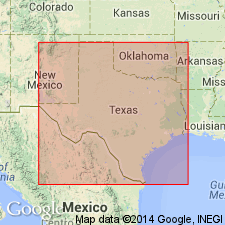
- Usage in publication:
-
- Gaptank formation
- Modifications:
-
- Original reference
- Dominant lithology:
-
- Limestone
- Shale
- Conglomerate
- Sandstone
- AAPG geologic province:
-
- Permian basin
Summary:
Pg. 47. Gaptank formation. Named by Udden. Consists of (descending): (1) mainly several masses of limestone separated by shaly and sandy material; (2) shales interbedded with limestones; (3) conglomerates alternating with limestones, sandstones, and shales. Thickness 1,500+/- feet. Is of [late] Pennsylvanian age, and probably = Cisco formation. Occurs at Gaptank, 24 miles northeast of Marathon, and extends short distance to southeast and 15 miles to southwest. [This definition included beds named Wolfcamp formation in 1917.]
Named for a tank, sometimes locally called "Gap Tank," located in a gap locally called Stockton Gap and Marathon Gap, southeast of Glass Mountains. [In vicinity of Lat. 30 deg. 26 min. 00 sec. N., Long. 102 deg. 57 min. 48 sec. W., Marathon Gap 7.5-min quadrangle, Pecos Co., western TX (USGS GNIS database and USGS historical topographic map collection TopoView, accessed on September 9, 2023).]
Source: US geologic names lexicon (USGS Bull. 896, p. 797-798).
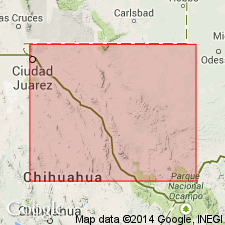
- Usage in publication:
-
- Gaptank formation
- Modifications:
-
- Revised
- AAPG geologic province:
-
- Permian basin
Summary:
Pg. 925. UDDENITES member of Wolfcamp formation is unconformable on underlying Pennsylvanian rocks [Gaptank formation]. On p. 910, authors state Gaptank correlates with Canyon and Cisco groups, based on fossils.
Source: US geologic names lexicon (USGS Bull. 896, p. 797-798).
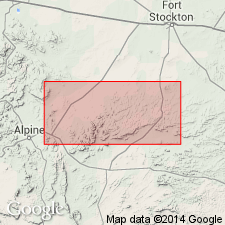
- Usage in publication:
-
- Gaptank formation
- Modifications:
-
- Revised
- AAPG geologic province:
-
- Permian basin
Summary:
Pg. 43-57. Gaptank formation. UDDENITES member included in base of Wolfcamp Formation (basal Permian). R.E. King and writer are convinced of Permian age of this member, which is unconformably on older beds. Present investigation has shown that Wolfcamp formation is present along almost the whole of Glass Mountains escarpment. Near type locality it consists in large part of green or blue clay shales, with rather abundant thin fossiliferous limestone beds; but to southwest, where the formation encroaches upon the strongly folded rocks, it becomes coarsely clastic, with several hundred feet of basal conglomerate followed by sandy shales with sparse fossils. Thickness at type locality 700 feet. For convenience of reference and mapping Wolfcamp formation is here divided into 3 members (descending): (1) Upper member, comprising about 3/4 of total thickness, is largely blue and green clay shales with thin layers of limestone, and contains unmistakable Permian fossils, including SCHWAGERINA, which first appears at base of this member; (2) the Gray limestone member, a rather thick-bedded, scarp-forming limestone about 50 feet thick, containing few fossils; (3) UDDENITES member, consisting of shale with a few thin limestone beds, and varying in thickness up to 300 feet. The UDDENITES member is exposed 0.75 mile northeast of summit of Leonard Mountain, but is absent west of Leonard Mountain, where basal beds of Wolfcamp formation are conglomerates, ranging from 10 feet thick west of Iron Mountain to 450 feet near Lenox. The Gaptank formation is 1,800 feet thick in vicinity of Gap Tank. Its basal bed is the CHAETETES limestone, 50 feet thick, characterized by large masses of CHAETETES MILLEPORACEOUS. [Gives detailed sections and fossil lists of Gaptank and Wolfcamp formations.] Conglomerates first appear in Gaptank formation several hundred feet above its base. They are 15 to 50 feet thick and 5 in number in one area. In upper 788 feet of Gaptank formation, are 5 limestones, 40 to 75 feet thick, separated by sandstones and shales. The 5th limestone is top bed of formation.
Source: US geologic names lexicon (USGS Bull. 896, p. 797-798).
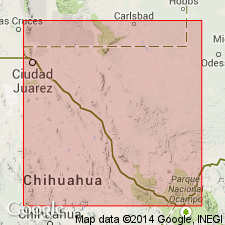
- Usage in publication:
-
- Gaptank formation*
- Modifications:
-
- Revised
- AAPG geologic province:
-
- Permian basin
Summary:
Gaptank formation revised in report area, Glass Mountains, Brewster Co, TX in Permian basin. Basal shale bed containing UDDENITES (an ammonoid) and abundant brachiopods removed from overlying Wolfcamp formation--base of Wolfcamp in the northeastern Glass Mountains here tentatively assumed to lie at the base of the gray limestone member that overlies the UDDENITES-bearing shales (Sellards (1933), however, places the contact at the top of the gray limestone). The fossil evidence afforded by this bed is, however, indefinite. The UDDENITES bed is considered to be Pennsylvanian [although not stated, it is assumed that the UDDENITES bed is placed in the underlying Pennsylvanian Gaptank formation]. In southwestern Glass Mountains basal Wolfcamp bed is a coarse conglomerate with underlying Gaptank separated from it by an unconformity. The unconformity and the conglomerates die out to northeast. Correlation chart. Is of Pennsylvanian age.
Source: GNU records (USGS DDS-6; Denver GNULEX).
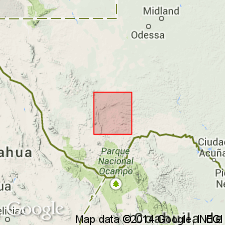
- Usage in publication:
-
- Gaptank formation*
- Modifications:
-
- Revised
- AAPG geologic province:
-
- Permian basin
Summary:
Pg. 73-92. Gaptank, as originally defined, evidently included strata now known as Wolfcamp formation. Later the Gaptank was restricted to exclude UDDENITES zone which Bose believed to be of Permian age. Further knowledge of fossils near Pennsylvanian-Permian boundary obtained in recent years has led to conclusion the UDDENITES zone is of Pennsylvanian age, and top of Gaptank is now placed above this zone. West of Marathon are exposures of strata, here considered to be part of Gaptank formation, which were variously placed in Tesnus (Baker and Bowman, 1917, Univ. Texas Bull., no. 1753), Haymond (Bose, 1917, Univ. Texas Bull., no. 1762) and Gaptank by Baker, Bose, and Udden. Term Dugout beds (Baker, 1928, AAPG Bull., v. 12, no. 11) has also been proposed for them. Gaptank formation crops out only in northern part of Marathon basin [this report]. Type area of Gaptank lies north of region of this report, but problematic strata exposed on Dugout Creek and here considered part of Gaptank formation crop out over wide area in northwestern part of Monument Spring quadrangle. Thickness at type locality about 1,800 feet; overlies Haymond formation; underlies Wolfcamp formation. In most places the Gaptank is separated from Wolfcamp by strong angular unconformity.
Source: US geologic names lexicon (USGS Bull. 1200, p. 1464).
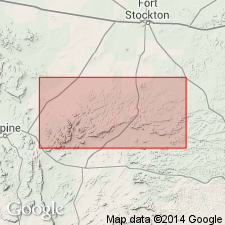
- Usage in publication:
-
- Gaptank formation
- Modifications:
-
- Revised
- AAPG geologic province:
-
- Permian basin
Summary:
Gaptank formation revised--upper contact changed in Glass Mountains, Brewster Co, TX in Permian basin. Nealranch formation (base) and Lenoxhills formation (top) first used in this report as replacements for Wolfcamp formation of Udden (1917) in Wolfcamp type locality (Wolf Camp Hills, Glass Mountains). "Nealranch formation embraces the upper part of beds originally called Wolfcamp by Udden (1917) in the Wolf Camp Hills and is renamed to retain this widely used name for the time-stratigraphic unit, the Wolfcamp Series." Lenoxhills formation unconformably overlies the Nealranch, Gaptank, and older strata of the Marathon orogenic belt. Nealranch unconformably overlies the "grey limestone" of King (1930 and 1937)--[this author's Gaptank formation]--in Wolf Camp Hills; the Pennsylvanian-Permian boundary is taken at this unconformity. The "Grey limestone" contains the youngest Pennsylvanian fauna in Wolf Camp Hills. Nealranch truncated and removed for some distance east of Wolf Camp Hills by pre-Lenoxhills erosion; Wolf Camp Hills, Gap Tank, foot of Lenox Hills, and probably base of Hess ranch horst are the only known outcrops of Nealranch in Glass Mountains. Throughout much of eastern Glass Mountains basal conglomerate of Lenoxhills fills valleys cut into Gaptank formation. Gaptank is Pennsylvanian (Cisco) age. Composite stratigraphic section. Fossils drawn and discussed in detail.
Source: GNU records (USGS DDS-6; Denver GNULEX).
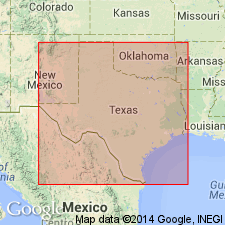
- Usage in publication:
-
- Gaptank Formation
- Modifications:
-
- Revised
- Age modified
- AAPG geologic province:
-
- Permian basin
Summary:
Gaptank revised--upper contact changed. The "Gray Limestone" (bed no. 2 of King, 1938) was placed by Ross (1959) in Gaptank; it is here removed from Gaptank and placed at the base of the overlying Wolfcampian Neal Ranch Formation. The age of Gaptank in the Glass Mountains (Brewster Co, TX in Permian basin) is modified--the "UDDENITES-bearing Shale Member," at top of Gaptank, is assigned to the lowermost Wolfcampian (Early Permian age); the rest of Gaptank is assigned to the Pennsylvanian. Age based on preponderance of faunal evidence as indicated by the brachiopods; the presence in the UDDENITES-bearing Shale Member of PARENTELETES, LIMBELLA, SCACCHINELLA, WAAGENOCONCHA, KOCHIPRODUCTUS, and GYPSOSPIRIFER indicates Permian age. Fossils listed and discussed. Measured sections. Correlation chart.
Source: GNU records (USGS DDS-6; Denver GNULEX).
For more information, please contact Nancy Stamm, Geologic Names Committee Secretary.
Asterisk (*) indicates published by U.S. Geological Survey authors.
"No current usage" (†) implies that a name has been abandoned or has fallen into disuse. Former usage and, if known, replacement name given in parentheses ( ).
Slash (/) indicates name conflicts with nomenclatural guidelines (CSN, 1933; ACSN, 1961, 1970; NACSN, 1983, 2005, 2021). May be explained within brackets ([ ]).

